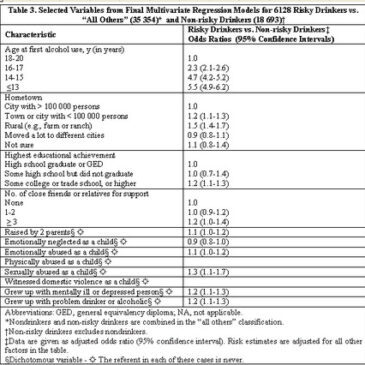For young people, the use and abuse of alcohol is alarming because of their still developing neuroanatomy, and the ease with which they can develop a dependency to alcohol (Molina, 2007; Padget, 2006). Using scientific studies to understand what leads adolescents toward future problematic alcoholic use can facilitate the development of more effective public health initiatives targeting underage alcohol consumption. This week, The DRAM discusses research that examines how adverse childhood experiences and the age of onset for first alcohol use contribute to young adults’ current use of alcohol.
Young, Hansen, Gibson, and Ryan (2006) surveyed 18-20 year old Marine Corps recruits with the Recruit Assessment Program (RAP) Questionnaire to gather data about their demographic, family and general history, and childhood experiences. They administered these surveys at the Marine Corps Recruit Depot in San Diego California from June 2002 to April 2006. After reviewing the initial 65,178 surveys, the researchers determined that 41,482 surveys were suitable for analysis; these surveys contained complete outcome and covariate data, and fit the criteria set forth by the researchers (i.e., 18-20 years old with no contradictory responses). The researchers conducted multivariate logistic regression analyses to assess associations between childhood factors (e.g., onset age, adverse childhood experiences) and young adult risky drinking patterns. The investigators Identified risky drinkers by using the AUDIT Alcohol Consumption Questionnaire.
Approximately one in seven (14.8%) of participants met the researchers’ criteria for risky drinking, and 45.1% satisfied their criteria for the non-risky drinker category; the other 40.2% were self-reported non-drinkers. The risky drinkers reported only slightly higher prevalence of experiencing child abuse or witnessing domestic violence compared to their non-risky drinking counterparts (see Figure). However, those recruits who reported first drinking around 13 years were 5.5 times more likely to engage in riskier drinking behavior than recruits who reported first drinking after age 13. Other significant and anticipated predictors of young adult drinking were smoking, having a rural or small town background, having grown up with someone who was a problem drinker or having grown up with someone who suffered from mental illness. Some unexpected correlates of risky drinking were achieving a higher educational level, having more close family members or friends, and being raised by two parents.
This study of young adult drinking had three key limitations: (1) self-reported data collection; (2) the large number of excluded surveys, potentially limiting the study’s representativeness; (3) the narrow sample (i.e., male military recruits). Despite these concerns, Young et al. (2006) provide support for the importance of age of onset to young adult drinking habits; however, they did not find adverse childhood experiences to be equally strong predictors of young adult drinking. Interestingly Young et al. (2006) noted that they did not expect to find that risky drinkers had a number of experiences that one might expect to be protective, such as, a higher number of close family and friends, a higher level of education, along with being slightly more likely to be raised by two parents. Young et al’s (2006) research shows that multiple and interactive factors, whether prototypically protective or detrimental, can be associated with harmful drinking behavior. The presence of protective childhood experiences does not guarantee a young adult life without substance abuse problems.
Figure. Multivariate regression models for risky drinkers and non-risky drinkers. Click image to enlarge.
—Ingrid R. Maurice
What do you think? Please use the comment link below to provide feedback on this article.
References
Molina, J. C., Spear, N.E., Mennella, J.A., Lewis, M.J. (2007). The International society for developmental psychobiology 39th annual meeting symposium: Alcohol and development: beyond fetal alcohol syndrome. Developmental Psychology, 49(3), 227-242.
Padget, A., Bell, M.L., Shamblen, S.R., Ringwalt, C.L. (2006). Does learning about the effects of alcohol on the developing brain affect children’s alcohol use? Prevention Science, 7(3), 293-302.
Young, S. Y. N., Hansen, C.J, Gibson, R.L, Ryan, M.A.K. (2006). Risky Alcohol Use, Age at Onset of Drinking, and Adverse Childhood Experiences in Young Men Entering the US Marine Corps. Archives Pediatrics & Adolescent Medicine, 160(12), 1207-1214.





